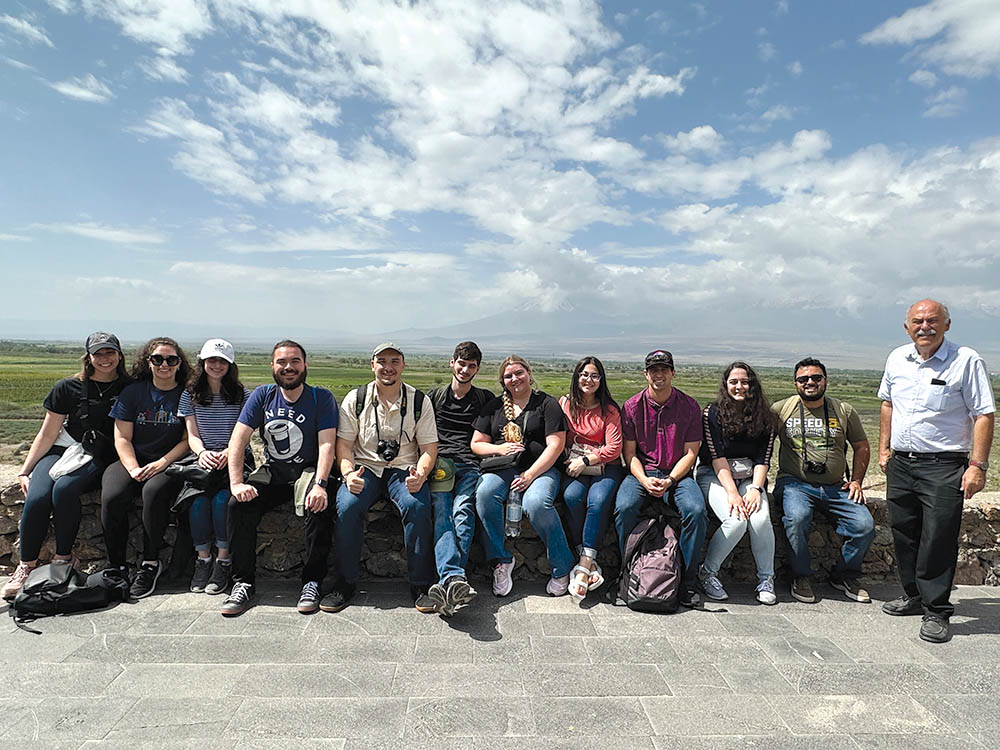
Christina Pambukyan, Charles Garabedian, and Prof. Barlow Der Mugrdechian at Khor Virap Monastery in Armenia.
Photo: ASP Archive
Careen Derkalousdian
Staff Writer
“I am grateful to be part of the Armenian community and to experience everything the country had to offer. I now feel that Armenia is full of rich history and beauty which I am privileged to have experienced. The impression I was left with of other Armenians is that they want to share the beauty and culture of Armenia with other Armenians no matter where in the world they are from,” said Julia Eritzian.
“It felt uncanny to see my own ancestors’ artifacts, to come to the realization that I am indigenous to this land, that these artifacts belonged to my ancestors. And to see my ancestors’ stories materialized into monasteries – St. Gregory’s pit or St. Hripsime’s grave, for instance –gave me a deeper understanding of the past. Something happened here, I kept thinking. And when I realized the weight of what has been salvaged for over two millennia, I realized the gravity of what has been lost in Western Armenia,” said Carina Tokatian.
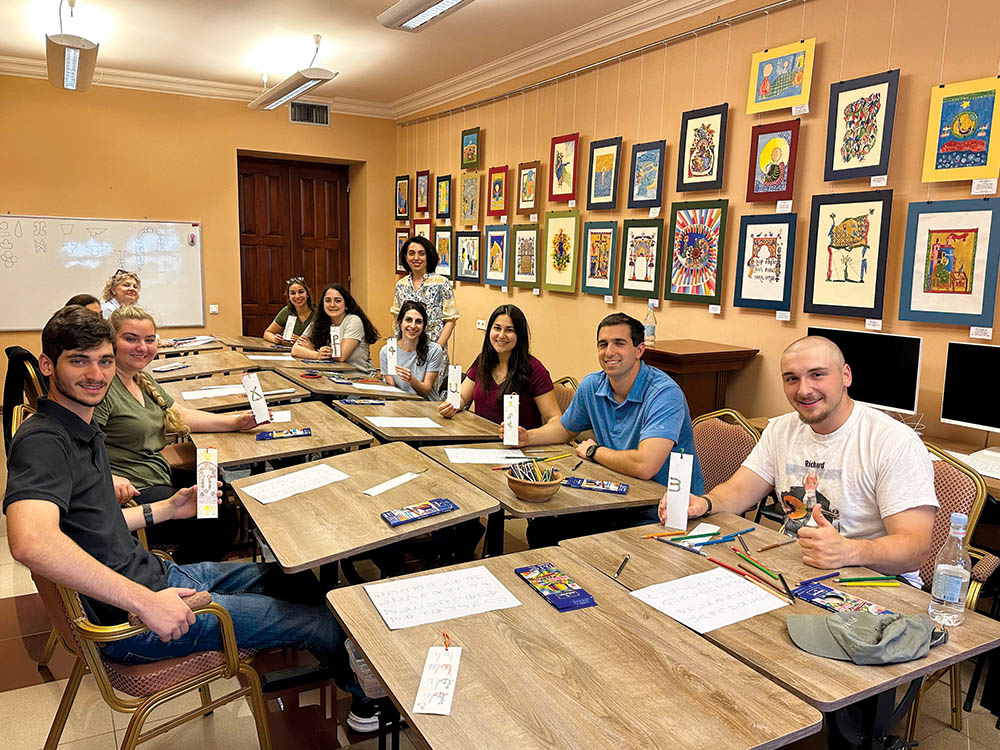
Photo: Barlow Der Mugrdechian
A group of 11 Fresno State students embarked on a once-in-a-lifetime trip to Armenia from May 23 to June 8, 2023, led by Professor Barlow Der Mugrdechian of the Armenian Studies Program. The students were filled with excitement, especially those who were visiting Armenia for the first time. The student participants were Caleb Arizmendez, Jonathan Chardukian, Careen Derkalousdian, Christa Eritzian, Julia Eritzian, Ariana Garabedian, Charles Garabedian, Michael Mazman, Christine Pambukyan, Carina Tokatian, and Dustin Vartanian.
The trip was organized as a three-unit class, “Armenia Today,” through the Division of Continuing Education. Financial support for student participants was provided through the Leon S. Peters Foundation and Fresno State Instructionally Related (IRA) grants.
After two lengthy flights, from Los Angeles to Paris, and then from Paris to Yerevan, the plane touched down at the Zvartnots International Airport. We were finally home.
After exiting customs, we were greeted by our kind and welcoming bus driver, Artak. Not long after, we arrived at the Ani Plaza Hotel, which would be our home for the next two weeks. Although it was late at night, the streets of Yerevan were lively and the locals stared at us with curiosity. The group made plans to meet in the morning and set off toward their rooms, excited for what the next day would hold.
In the morning, the group met up for a delicious and abundant breakfast buffet in the hotel dining room. This first day was spent exploring the bustling streets of Yerevan. Prof. Der Mugrdechian led the walking tour of the city, which felt like walking through history. Our first stop was the Gatoghige Church, just across the street from the hotel on the corner of Abovian and Sayat Nova. It was our first glimpse of the beautiful architecture that traditional Armenian churches have to offer. On this day, we also explored Freedom Square, the Cascade, St. Sarkis Armenian Church, and visited the Mother Armenia monument.
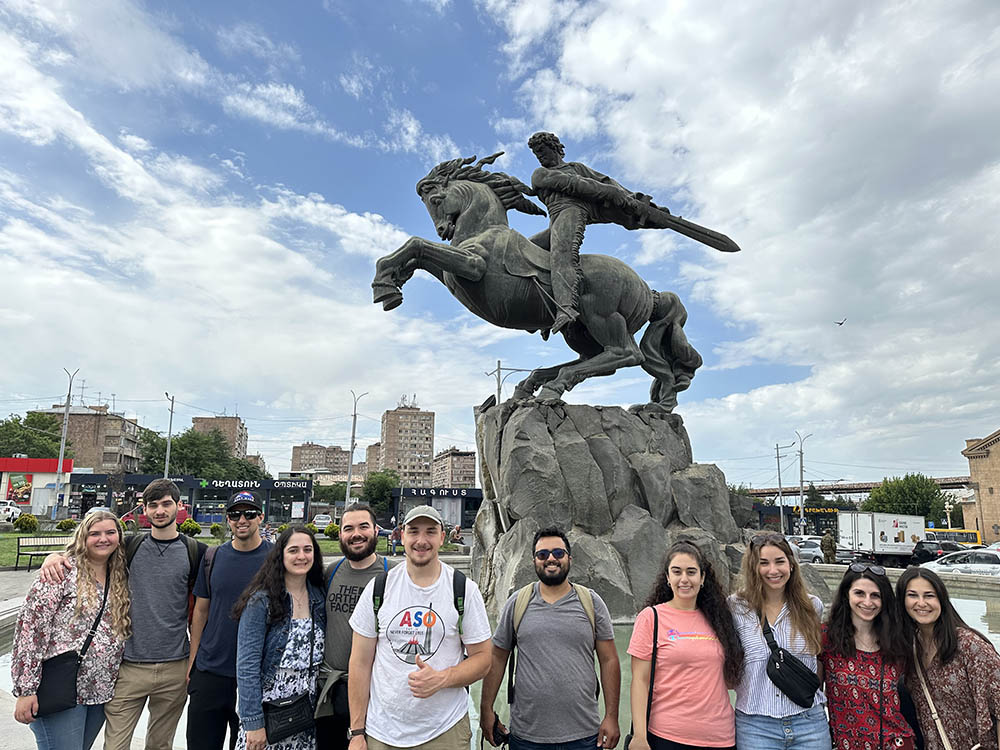
In the afternoon, we paid a visit to Mer-Hooys (House of Hope), a home for young girls from disadvantaged backgrounds that provides them with support and opportunities. We got to know the girls and played games with them. They also showcased their wonderful musical talents by singing and playing the piano for us. It was uplifting to see our Armenian youth nurturing their talents and striving for their goals.
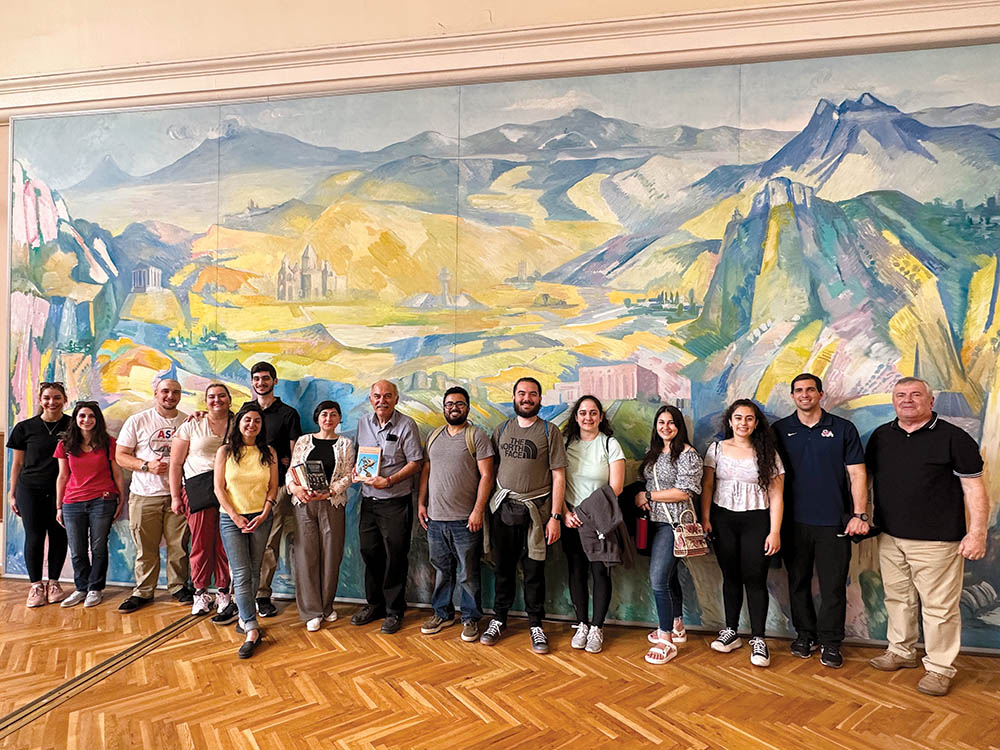
Photo: Barlow Der Mugrdechian
Each day was packed with new adventures and more history to be learned. One of the most notable sites that the group visited was Khor Virap. We were all familiar with the story of how St. Gregory the Illuminator helped bring Christianity to Armenia, but descending the very pit that he had been imprisoned in was surreal. We felt deeply connected to the story in a way that we had never felt before. This was true of all the historical sites we visited.
The Erebuni fortress built by King Argishti I of Urartu in 782 BCE provided another example. Although only its ruins remain, one can almost picture the king walking through what was once the fortress.
Another notable site that we explored was the Areni-1 cave in the southern region of Armenia, where the world’s oldest shoe was discovered and the world’s first winery was excavated, both being over 6,000 years old. We were all in awe at the rich history that this single Armenian cave had to offer, not to mention the several other historical sites we visited such as the fortress of Amberd and the Temple of Garni.
We also visited museums such as the Matenadaran Manuscript Library, where we were allowed special access to the manuscript vault and restoration areas. We visited the Armenian Genocide Museum at Tsitsernakaberd, and there were met by Dr. Harutyun Marutyan, director of the Armenian Genocide Museum-Institute, who gave students a special guided tour of the grounds.
In every church and monastery, God’s presence was undoubtedly felt. One that stood out to many was the St. Mary church in Odzun, where it is said that the infant swaddling clothes of Jesus Christ are buried. We arrived in the early evening, just as the bright sun was peeking through the clouds, giving the church’s pink tufa stone a glowing appearance. The village children were playing in the church field and their sweet laughter could be heard. Upon entering, we noticed a simple but beautiful altar, with the image of the Virgin Mary and infant Jesus Christ above it. Students lit candles and said their prayers. After making the sign of the cross and exiting the church, we walked to the two memorial obelisks, which are next to the church. These obelisks depict the history of Christianity, with scenes from the Old and New Testaments as well as the Armenians’ acceptance of the faith. On our way back to the bus, a priest offered to pray for us.
Student Christine Pambukyan in her essay writes that “After being blessed by the priest at the church of Odzun, a beautiful double rainbow appeared, adding a surreal beauty to our experience. It was as if our blessings and prayers had been heard. I hope to revisit the region again one day.”
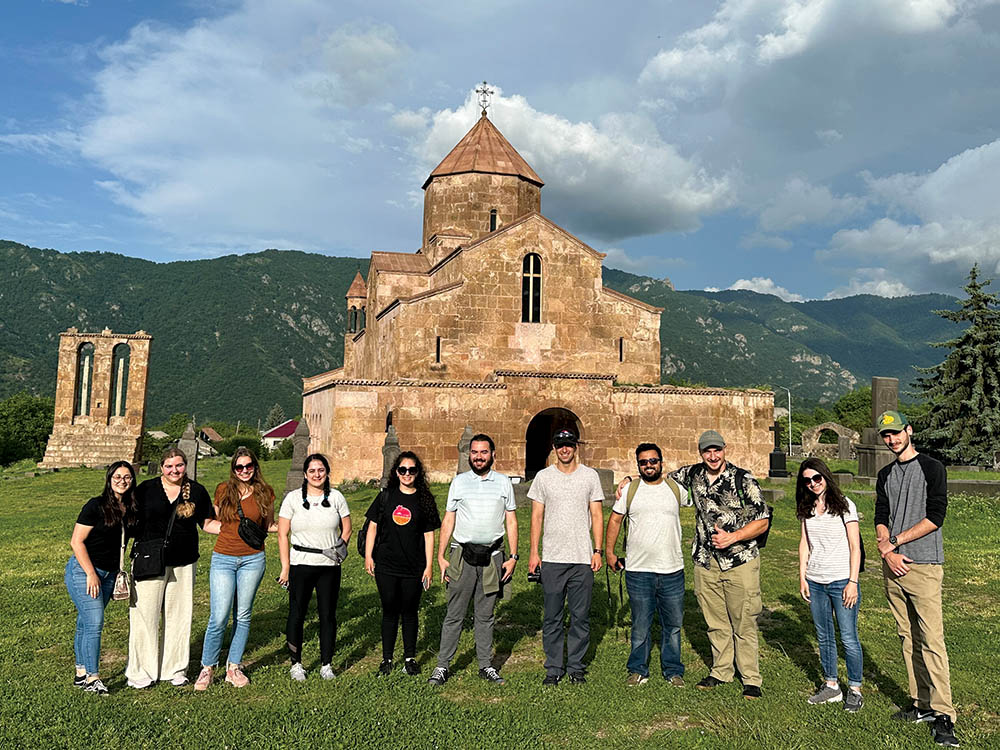
Photo: Barlow Der Mugrdechian
The monasteries of Haghbat and Sanahin in northern Armenia were set in the beautiful forests of the Lori region. We also visited several other churches, including the Geghart Monastery, Noravank, and the St. Gregory Church. From Geghart’s vibrant greenery and rocky mountain sides to the fiery red cliffs surrounding Noravank, the views from these churches were breathtaking! At Geghart, we viewed the intricately carved khachkars as we walked towards the church. The inside of the church was dark, with some light shining in through an opening in the ceiling. A small choir arrived and began to sing the Hayr Mer [the Lord’s Prayer]. Their beautiful voices filled the air, with the grand acoustics of the church echoing their melodies. It was a moving performance. Another touching sight to see was witnessing those praying on their knees in the St. Gregory Church, the largest Armenian church in the world, built in 2001 in the heart of Yerevan. The unwavering faith of our people is incredible.
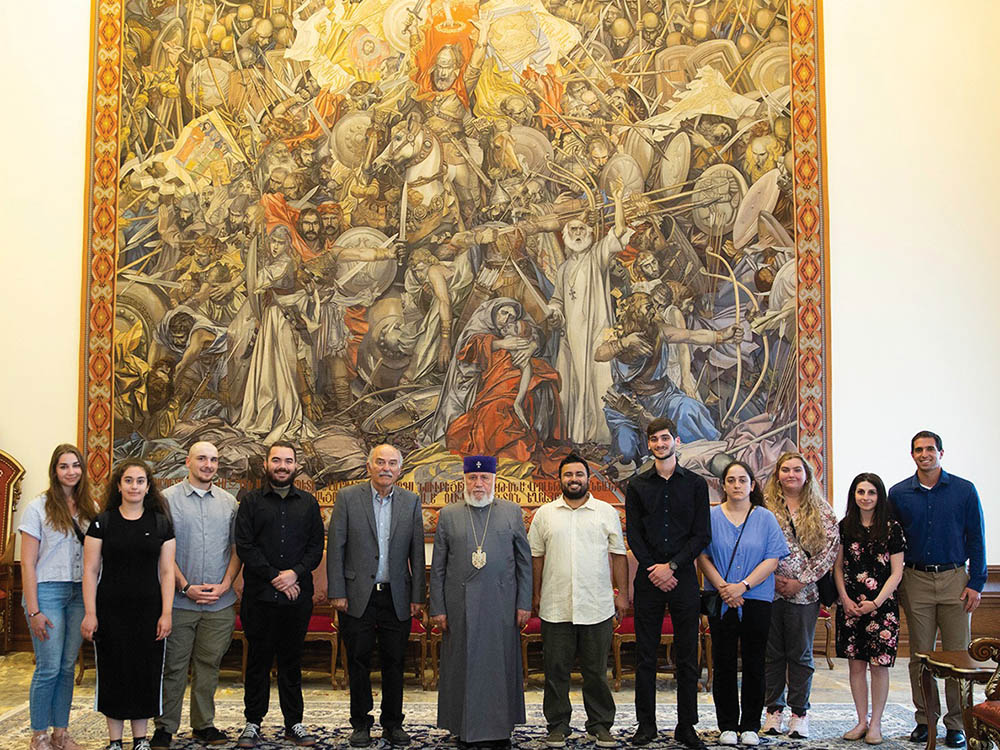
Thanks to Prof. Der Mugrdechian, we had the honor of meeting His Holiness Karekin II, Catholicos of all Armenians at Holy Etchmiadzin. The students were able to ask him questions and engage in conversation. The Very Rev. Fr. Garegin Hambar-dzumyan gave us a tour of the Etchmiadzin museum, full of artworks and artifacts related to past Catholicoi. One of the artworks we viewed was the Armenian alphabet engraved in gold and bejeweled, which had been commissioned by the late Catholicos Vazken I. Gesturing towards the art, Fr. Garegin stated that our alphabet starts with Asdvadz (Ա) [God] and ends with Christos (Ք) [Jesus], a statement that the students found very profound. From Etchmiadzin, we were also able to see a clear view of Mount Ararat, with its white, snowy peak contrasting the blue sky.
Most evenings, the group would come together for a delicious meal and share highlights from the day. The restaurant would be full of our laughter as we shared our favorite anecdotes and different perspectives. We would walk the lively streets of Yerevan at night, full of crowds speaking our beautiful language and enjoying our fantastic cuisine. Yerevan nights are surely an aspect of Armenian culture that have captivated us all.
On June 8th, as we boarded our flight back to Los Angeles, our hearts were full and our minds expanded. There is history waiting to be told in every corner of Armenia, and we were able to witness it firsthand. Our traditional music, dishes, and ancient history are preserved. We continue to worship God and pray in our ancient churches. We continue to have faith. Every sight that we saw and learned about further fueled our love for our rich culture and beautiful country. We forged lifelong friendships on this trip and made memories that will be cherished forever. Long live Armenia—our Armenia.
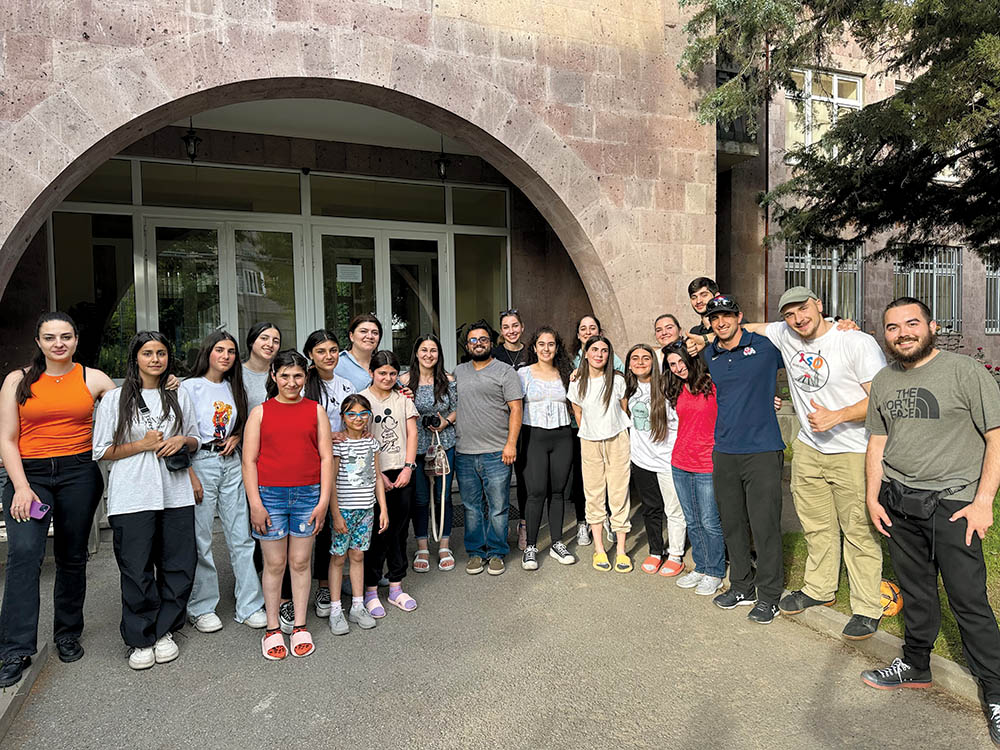
Photo: Barlow Der Mugrdechian
“One of the lasting impacts of my visit to Armenia is the deep appreciation I gained for the country’s rich history and culture. Before my trip, I considered myself to be knowledgeable about Armenia’s historical significance and cultural heritage. However, immersing myself in the country allowed me to see the enduring legacy of the Armenian people and their achievements throughout the ages. Visiting places like ancient Christian monasteries and archeological sites gave me a sense of connection to the past and made me realize the importance of preserving such historically significant places.” Michael Mazman
“That is what fascinated me the most in Armenia: stories made tangible through artifacts and architecture. Even Tsitsernakaberd’s location, in prime view of Mt. Ararat, tells a story. As our tour guide highlighted, their juxtaposition symbolizes the parallels between the two accounts: Noah’s Ark and the 1915 Genocide. Both represent stories of mass extermination but also stories of salvation.” Carina Tokatian
“Traveling to Armenia has given me memories that I will never forget. I am grateful I obtained this opportunity to travel abroad. It made me perceive the country and the locals differently than I did prior to visiting. I now feel closer to the culture regardless of the physical distance between America and Armenia. I hope to return soon to fulfill missionary work as a contribution to Armenia’s development.” Christa Eritzian
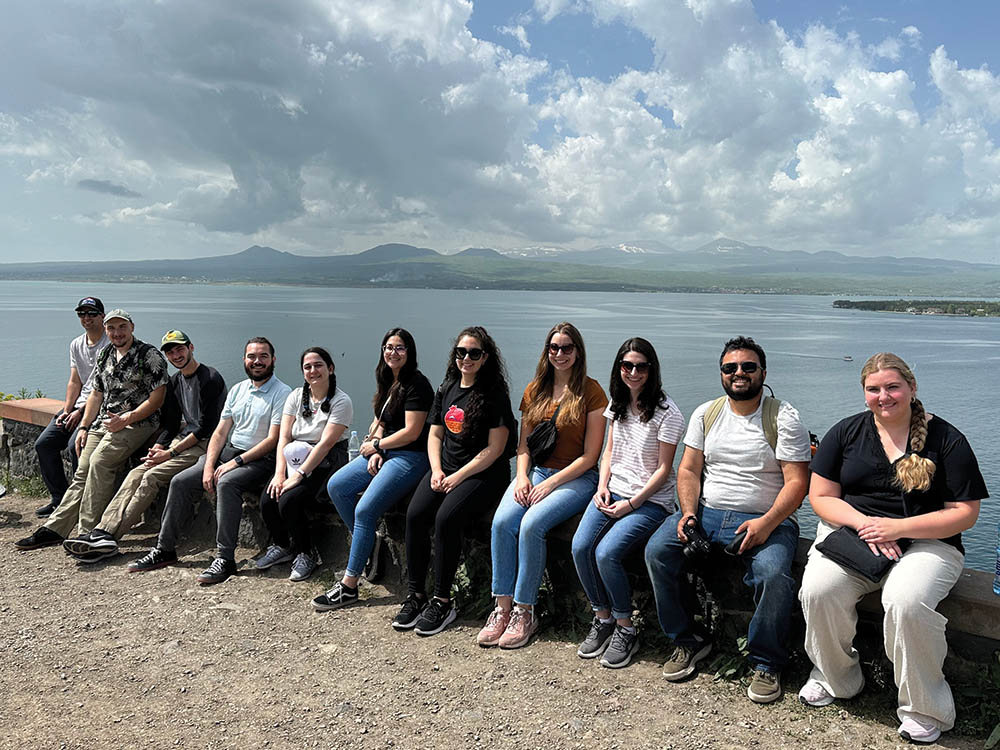
“This trip was my second time visiting Armenia. This time I had a more educated lens as I revisited monasteries and got to visit new regions of Armenia that I had not had a chance to before. I also got to see family I had not visited in years and experienced Armenia in a way I know I will not be able to recreate.” Christine Pambukyan
“Overall, this trip has certainly changed my view of the modern country of Armenia; I do not have much of an ancestral connection to the country being a Western Armenian, but, as Dr. Hrag Papazian helped me realize, having a tangible homeland as an Armenian is an incredibly important thing for us to have access to, especially when that homeland is ancestral and full of our rich history.” Jonathan Chardukian
 Hye Sharzhoom Armenian Action
Hye Sharzhoom Armenian Action